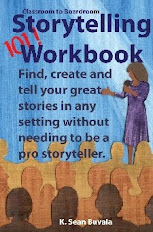Sometimes it is hard for the others in your company to understand the ins and outs of the mysteries of technology and research. By using the power of storytelling techniques in your communications, you can create the "frames" to highlight, carry and explain the bigger concepts of your work.
Every house I have ever been in has a wall or table filled with pictures of family and friends. Rather than just glue these pictures to the wall, the pictures are placed in frames that help draw the eye to the subjects contained within. In the most artistic of homes, the frames surrounding these pictures have been carefully chosen to help emphasize the content of the pictures. Done well, the frames are an extension of the pictures. The more important the pictures (the "everybody in the family" type) have the most expensive and sturdy frames.
Just like these picture frames in someone's home, your ability to frame your complicated and important data in the context of a memorable story will protect and carry your message to your listeners.
Let me give you an example of how this works.
You could talk about the collection methods used to complete a survey and how that proves the validity of the data. However, folks want results first. So, instead of talking first about how the data means you must completely drop an ingrained and "sacred cow" program from your company, you could start with the story of "Jack and the Beanstalk," (JATBS) emphasizing how Jack's mother was furious with Jack for trading her sacred cow for a few magic beans. However, in the end, Jack ends up with a goose that lays golden eggs, giving Jack and his mother more than they ever dreamed of.
You will the present your data after you tell your version of JATBS, showing the data that correlates to your conclusion. Then, you might lead a discussion based on the data that asks, "Just like the mother in JATBS, what do we in our company fear from what the data tells us? In what ways is this data like magic beans for our company's future?"
You can then end your presentation with a recap of JATBS. Now, you have framed your data (data is important and needed) in the center of a very familiar and comfortable story. I can assure you that the first time you do this process, you will wade through some discomfort and come out with a presentation that will cement the conclusions of your data into the minds of your listeners.
Here are three things you should know about story and narrative as framing tools.
1. People just want to know "what's in it for me?"
Your fellow employees are not as interested in the mechanics of your job as you are. I know you have gone to school to learn how statics work. I know you understand the many ways to hook up one computer to another in your office. However, the people you work with have not gone to the same schools you have. For most of them, how you collected the data is not nearly as important as what the data implies and instructs for their work. Storytelling lets you talk about benefits of research and technology, not just mechanics.
2. Stories remind you to speak in the language of the people: your fellow employees.
Although the idea of the uncommunicative IT employee is an unfair cultural joke, there are those in your company that are still slightly afraid of you. When they know you will speak in ways they understand, they are more open to hear what you have to say. When you can give folks the story of how others have benefited by the work you are proposing, they will feel better about providing you the tools and time to fulfill your projects. In a sense, storytelling allows others to know you are "on their side." It's far better to talk to others about how Susan at the other office could get twice as much work done in the same amount time after the expensive software update you have proposed rather than list of the uncommon features of database processing.
3. Your CFO approves funds for results not information.
Most people hate the process of change. Results are better than promises. Stories are the frames that carry results. You will get much more support for any project when folks know how others have benefited from your proposals. How the office across the city became so efficient that they now have a four-day workweek is one-hundred percent more effective in getting results than any presentation of how a Blade server works.
Your work in statics, data and technology is vital to your company. Even more vital is your ability to communicate the benefits of your work to the rest of your company through good business presentation skills. Information framed in the context of story, information carried by understandable narratives, will stick with your fellow staff members much longer than data alone. Take a chance and frame your next presentation in story.
Go deeper into this subject on how to create a story with my short-and-focused book on designing your stories: "Measures of Story," over on Amazon.
***
Sean Buvala is an award-winning trainer who teaches businesses and nonprofit organizations how to grow their bottom line and employee satisfaction through the power of storytelling. You learn more about his work at www.seantells.com. Follow him at Twitter @storyteller .
The official blog for K. Sean Buvala, storyteller and storytelling coach.





No comments:
Post a Comment